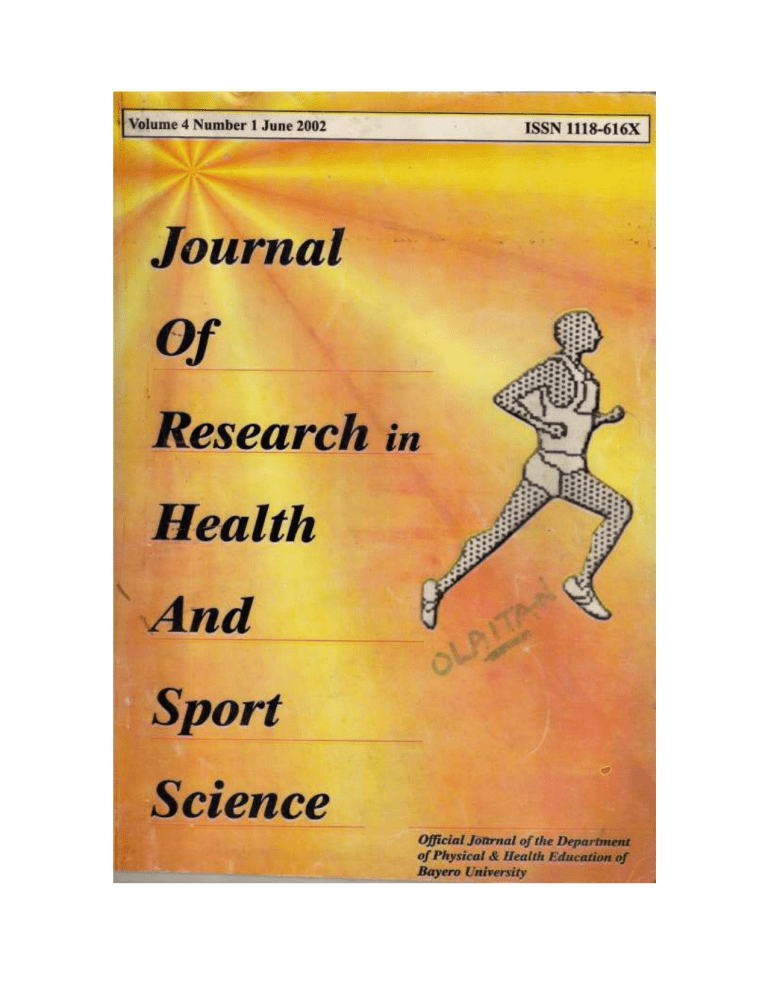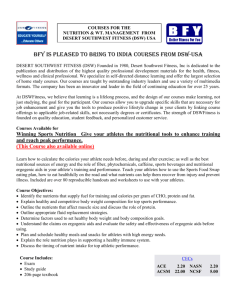Document 16112197

EDITORIAL BOARD
Associate Professor D.I. Musa - Editor-in-Chief
Dr. Badamasi Lawal
Dr. Gambari Mohammed
-
-
Managing Editor
Production Editor
Dr. A.G. Suleiman
Sadiq Ismaila
-
-
Member
Member
Mohammed S/Fawa - Secretary
CONSULTING EDITORS
Professor Sharon Ann Plowman - Northern Illinois University,
U.S.A.
Professor James Ajala
Professor K. Venkateswarlu
Professor V.C.B. Nwuga
-
-
-
University of Ibadan
Ahmadu Bello University
Obafemi Awolow University
Professor F.A. Amuche - University of Nigeria
ASSOCIATE EDITORS
Professor P.B. Ikulayo
Professor M.A. Chado
-
-
University of Lagos
Ahmadu Bello University
Professor B. Mshellia
Dr. Kola Lafinhan
Dr. S.A. Adeniran
-
-
-
University of Maiduguri
University of ILorin
Obafemi Awolowo University
ALL ARTICLES FOR PUBLICATION TO:
The Managing Editor, JORHASS, C/O Department of Physical & Health Education,
Bayero University, Kano, Nigeria. Articles are accepted at any time of the year.
Authors should comply with the latest APA style, especially with regards to citations and references.
JORHASS – The Official Journal of the Department of Physical & Health
Education of Bayero University, Kano, Nigeria. Vol. 4, No 1, June, 2002.
© PHE-BUK, 2002
ISSN 1118-616X
TABLE OF CONTENTS
The impact of environmental sanitation on the incidence of gastroenteritis among inhabitants of Bida Local Government Area of Niger State B. O.
Ogundele & Nma Yabagi 1
The perception of correlates of bottle-feeling by the lactating working mothers
In Kano State secretariat Mohammed S. Fawa 6
Rennin Angiotensin System (RAS) contributes little to acute nicotine-induced pressor response A. U. Dikko & H. A. dikko
A profile of common health related problems of retired male athletes
10
A. E. Talabi & O. L. Olaitan 16
Toward effective evaluation of health education programme Badamasi Lawal 20
Growth patterns of Nigeria secondary school adolescents J. A. Gwani
Physical fitness level of mentally retarded children age 16-18 years
23
Rabi’u Mohammed
Impact of zonal system on sports development in Nigeria
27
A. I. Kabido, K Venkateswarlu & F. B. Adeyanju
Correlation between corporate sports sponsorship selection criteria and reasons
31
For sponsorship attrition in Nigeria Nebath Tanglang
Gender Equity and Equality: Issues in Nigeria University Games (NUGA)
36
A. Kaidal 43
Education and cultural beliefs as determinants of low female leadership positions
In sports management in Lagos State sports Council
E. O. Marakinto & Jennifer C. Orisakwe
The role and significance of leisure recreation and tourism in personal
47
Health development information individuals A. G. Suleiman
Effects of training frequencies of 3 days and 5 days per week on aerobic power
51 of University amateur athletes M.W.U. Gaya B. S. Mshelia & A. A. Sanusi 56
A PROFILE OF COMMON HEALTH RELATED POBLEMS OF RETIRED
MALE ATHLETES
Abstract
The study looked into the health related problems of retired (male) athletes.
About ninety two (92) retired athletes age ranging from 45- 60 years took part in the study. The study found that over seventy percent of retired athletes suffer from over weight (87.65%), dizziness (80.83%), headaches (79.28%), general body weakness (76.79%), sexual excellent (72.43%) and rise in blood pressure,
(72.58%) among others. Less than 3.0% have been hospitalized, have stroke, diabetes, ulcer, rheumatism, depression, asthma and arthritis. The study concluded that low to moderate activity pattern after retirement could induce high level of health benefits until old age. The study therefore recommended that physical exercise should be engaged in regularly for over-all health.
JORHASS 2002; 4 (1)..
The term ‘retired athletes’ refers to those athletes who have participated in high intensity physical activities in one sport or the other for a very long time and have retired from active sports participation. This could be due to old age, injury or other demands of life.
Physical training exposes the various systems of the body to potent physiological stimuli. These stimuli induce specific adaptations that enhance an individual’s tolerance for the type of exercise encountered in the training. The level of adaptation and the magnitude of improvement in exercise tolerance is proportional to the potency of the physical training stimulus (Colyle, 1988).
The effect of regular physical activity in promoting aerobic fitness is extensively documented (Armstrong & Welshman, 1997; American college of
Sports Medicine 1988; Saltin, 1990). Evidence is also accumulating that there is a dose-response relationship between physical activity and low blood lipids
(Durstine & Haskell, 1994; Wood & StenCanick, 1990), reduced blood pressure
(Hagberg, 1990; Tipton, 1991), reduced obesity (Bray, 1990; Stefanick, 1993), reduced risk of osteoporosis (Despres, et al, 1990 and SnowKarter & Marcus,
1991) and increasing psychological well being (Brown, 1990; Noris, Carroll &
Cochrane, 1991).
While there is growing evidence that adaptations to exercise training are transient and rill steadily decay once training ceases, (Colyle, 1988; Armstrong
Welshman, 1997), it seems that the health benefits of exercise may persist for a much longer time (Colyle, 1988), and that adults’ health and well-being may have its origin in behaviours established during earlier years (Activity and l-
Health Research, 1992; Coronary prevention Group, 1989; Loucks, 1998).
The highlight of this paper is on the time course of loss to health status when exercise training is stopped. That is, are these health- induced abilities of people who have ceased prolonged and intense training maintained for long?
This paper also intends to highlight the common health problems of retired athletes with a view to advise on possible future problems when they retire,
Methodology
Ninety-two (92) retired athletes from six states in Nigeria took part in the study. All athletes were between 45 and 60 years of age, all have represented their Colleges/University/States in national championships. All have actively participated in their sports of choice for between eight and fifteen years. All have retired from active participation in sports.
The self-validated Retired Athlete Profile Format (RAPF) was used to collect data on some health problems of retired athletes. Athletes were free to select from the list of health variables that are applicable to them. Only those health variables with seventy percent and above frequency of occurrence were selected as valid for this study. Also, selected as valid for this study are health variable that have less than twenty percent (20%) frequency of occurrence.
Results and Discussion
The results for this study are presented in tables I to 3. TabIF I details the profile of the retired athletes.
Table 1: Profile of Retired Athletes
No - 92
Age
Sex
Years of participation
Level of active participation
Present level of activities
- 45-60yrs
- Male
- 8-15yrs
- College/University/State/National
- Low/Moderate
This study was limited to male players who were 45 years and above. This is to guarantee that they are fully retired. All participants had over eight years of continuous involvement in sports in at least college or university level. This is to ensure that the level of participation was intense enough to induce specific
effects on the systems. All participants were involved in normal life routine of low to moderate level of activity at the time of study.
Table 2: High Frequency Health Related Problems of Retired (Male)
Athletes (n = 92)
Health problems
Overweight
% Frequency
87.65
Dizziness
Headaches
Backaches
80.53
79.28
77.36
Over eating
General body weakness
Rise in Blood Pressure
Sexual excitement
Tension
77.25
76.79
72.58
72.43
71.35
In table 2 are health problems that had seventy percent (70%) frequency of occurrence among those selected for this study? Highest on the list are overweight, dizziness and headaches. Lowest are sexual excitement and tension.
Evidences from Armstrong and Weishman (1997); Mc Ardle, et al, (1986) and 1-laskell, (1985) indicated that excess weight gain is closely related to reduced physical activity and increased calorie intake. The reduced activity level of these retired athletes coupled with the tendency to over-eat which has a
77.25% occurrence in table 2 will guarantee that they are likely to experience weight gains.
When people detrain after several years of intense training, they display large reductions in stroke volume and V02 max (Colyle, 1988). The implication of this is that the volume of blood pumped to all parts of the body is decreased.
The reduced Physical activity without a complimentary reduction of mental activity means that the supply of blood to the brain becomes grossly inadequate and that can result in the dizziness and headaches experienced by these retired athletes.
Retired athletes in this study also tend to have problems of backache
(77.36%), and general body weakness (76.97%) as shown in table 2. When physical training ceases, the bodily systems readjust in accordance with the diminished physiological stimuli and many training induced adaptations are reversed to varying extents (Colyle, 1988). The decline in muscular strength and endurance as a result of detraining definitely could induce the general body weakness, with the loss of trunk and abdominal body strength. The loss of trunk and abdominal muscle strength have been implicated in low back pain (Sherry and Wilson, 1998).
Retired athletes in this study generaky experience tissue tension and sexual excitement as indicated in table 2. This phenomenon could be explained as
“over build-up oibioelcctrical charges’ in the body. Reich (1973), Bean (1975) and Kelly (1983) concluded in their theory of “muscular armoring” and
“neurosis” that excess bio-electrical energy flow in the body which is normally discharged during physicri activity and other strenuous situations begins to build-up in the body due to the reduced activity level. The rediction in electrical discharge leads to excessive bui i-tip of bioelectrical charges in the body. According to Reich, (1973), Bean (1975) and Kelly (1983) this exceSs bio-electric discharges is felt as sexual excitation, which is a result of tissue tension, in healthy individuals.
Table 3: Low Frequency Health Related Problems of Retired Athletes
(n=92)
Health problems
Inability to Sleep
Serious Infections
Special Medical Treatment
% Frequency
15.23
10.72
10.25
Hospitalization
Rheumatism
Arthritis
Ulcer
Depression
Stroke
Asthma
Diabetes
0.00
0.00
0.00
0.00
2.55
2.42
0.84
0.73
Table 3 shows some health related problems which have a low frequency of occurrence among retired male athletes. Results show that athletes who retire after many years of strenuous physical activity tend to be free from Stroke,
Asthma, Ulcer, Depression, Diabetes, Arthritis, Rheumatism and serious hospitalization if they continue with low to moderate intensity activity life style.
According to Colyle, (1988) even though detraining leads to a decline in function of the bodily systems, these declines do not indicate a deterioration of the heart functions, but are largely due to the reduced blood volume and ability of’ the heart to return venous blood to the heart. They also concluded that detrained athletes however, do not regress to levels displayed by individuals who never participate in exercise training.
This clearly shows that there is a carryover effect of exercise on health and this carry over could last for some time. Also, the notion that it is physical activity rather than physical fitness per see that affects cardiovascular health which has been echoed by Simon-Morton, et al, (1987) clearly indicates that a life long moderate to low physical activity level could guarantee card io-vascular health for life (Mc Ardle et al, 1986)
About 15.2%, 10.72% and 10.25% of retired (male) athletes tend to suffer from inability to sleep. serious infections and go for medical treatment respectively. Some of the reasons advanced by these ones include worry over life’s burden, malaria infections and sometimes-household accidents. These
conditions are however generally not always life threatening and do not involve hospitalization.
The benefit of physical exercise are too numerous to mention, and scores of scholars have advocated exercise for health, longevity and fitness among others. This preliminary study has added to the notion that health benefits of exercise far out way the risk involved and that the benefits could persist long into old age with low to moderate activity pattern.
Recommendations
Based on the analysis of findings, it is hereby recommended that, to be healthy, physical activities should be engaged in regularly. Especially at the early ages of life, individual should cultivate habit of taking part in various physical exercises, which could help to avert certain problems such as stroke, sleeplessness etc later on a life.
Retired athletes should also continue to engage in low to moderate physical activities for as long as possible.
References
Activity and Health Research (1992). Allied Dunbar National Fitness Survey.
London Sports council and Health Education Authority.
American College of Sports Medicine (1988). Opinion Statement on physical fitness in children and youth. Medicine and Science in sports and Exercise.
20, 422-423.
Armstrong, N. & Weishman, J. (1997). Young People and Physical Activity. New
York: Oxford Medical Publications.
Bean, 0. (1975). Me and the Orgone. New York:St. Martins Press.
Bray, GA. (1990). Exercise and Obesity. In C. Bouchard, R.J. Shephard; T.
Stepheson, J.R. Sutton & B.D. McPherson (Eds.), Exercise, Fitness and
Health, Champaign, IL: 1-luman Kinetics, pp 497-5 10.
Brown, DR. (1990). Exercise, fitness and mental health. In C. Bouchard, R.J.
Shepherd, T.Stepheson, J.R. Sutton & B.D. McPherson (Eds.), Exercise,
Fitness and Health, Champaign, IL: Human Kinetics, pp 607-626.
ColyTa, E.F. (1988). Detraining and Retention of training-induced adaptations.
Resource Manual for Guidelines for Exercise testing and prescription,
American College of sports Medicine. Philadelphia: Lea & Febigger.
Coronary Prevention Group (1989). Should the prevention of coronary Heart
Disease begin in childhood? London; Coronary Prevention Group.
Despres, J. P., Bouchard, C. & Malina, kM. (1990). Physical activity and Coronary
Heart Disease risk factors during childhood and adolescence. Exercise and
Sports Sciences Reviews, 18, 243-261.
Durstine, J.L and Haskell, W.L (1994). Effects of Exercise Training on plasma lipids and lipoprote ins. Exercise and Sports Sciences Reviews, 22,477-
521.
Gaesser, G and Rich, R (1984). Effects of high and low intensity exercise training on aerobic capacity and blood lipids. Medicine and Science of Sports of
Exercise, 16, 269-274 l-lagberg, J.M. (1990). Exercise Otncss and hypertension. In C. Bouchard, R.J.
Shepherd, T. Stephens, J.R. Sutton and B.D. Mc Pherson (Eds.), Exercise,
Fitness and Health. Champaign, IL, I lunian Kinetics, pp. 455 - 466
Haskell, V. (1985). Physical activity and health: Need to define the required stimulus. American Journal of Cardiolo, 55, 41 -91.
Kelly, C. (1983). Reich and Radix: A Memoir, Radix Journal, 3, No.1 pp9-40
Loucks, A.B. (1988). Osteoporosis prevention begins in childhood. In E.W. Brown and C. F. B ranta (Eds.), Competitive sports for Children and Youth.
Champaign, IL; Human Kinetics, pp 2 13-223.
Mc Ardle, W.D; Katch, F.I and Katch, V.L. (1986). Exercise Physiolo. Philadelphia;
Lea & Febigger.. Nlontoye, 1-IS. (1987). Better bones and biodynamics.
Research Quarterly for Exercise and Sports, 58, 334-343.
Norris, J; Carroll, D. & Cochrane, R. (1991). The effects of physical activity and exercise training on psychological stress and wellbeing in an adolescent population. Journal of clinical Psycholog’. 36, 5 5-65.
Reich. W. (1973). The Function of the Organism. N.Y. The Pocket Books.
Saltin:. B. (1990). Cardiovascular and Pulmonary adaptation to physical activity.
In C. Bouchard, R. J. Shepherd, J.R. Sutton, & B.D. McPherson (Eds.).
Exercise, Fitness and Health. Champaign, IL; Human Kinetics, pp 187-204.
Sherry, E. & Wilson, F.G. (1998). Oxford handbook of sports medicine. N.Y.,
Oxford University Press.
Simon-Morton, B .G., Olfare, N.M., Simon-Mortan, 0G. & Parcel, G.S. (1987).
Children and Titness: A Public Health Perspective. Research Quarterly for
Exercise & Sports, 58. No. 4 pp 295-303.
Snow-I-Iarter, C. & Marcus, R. (1991). Exercise,bone mineral density, and osteoporosis. Exercise and sport Sciences Reviews, 19, 35 1-3 88.
Stefanick, M.L. (1993). Exercise and diabetes mellitus. Exercise and Sport
Sciences Reviews, 22, 363-396.
Stephens T.; Jacobs, DR. & White, C.C. (1985). A descriptive epidemiology of leisure time physical activity. Public Health Reports, 100, 147-158.
Tipton, C.M. (1991). Exercise, Training and hypertension: an update. Exercise and Sport Sciences Reviews, 15, 447-505.
Wood, P.D. & Stefacnick, M. (1990). Exercise, fitness and atherosclerosis. In C.
Bouchard, R. J. Shepherd, T. Stephens, JR. Sulton & B.D. McPherson
(Eds.), Exercise, Fitness and Health. Champaign, IL; Human Kinetics, pp
409-24.




